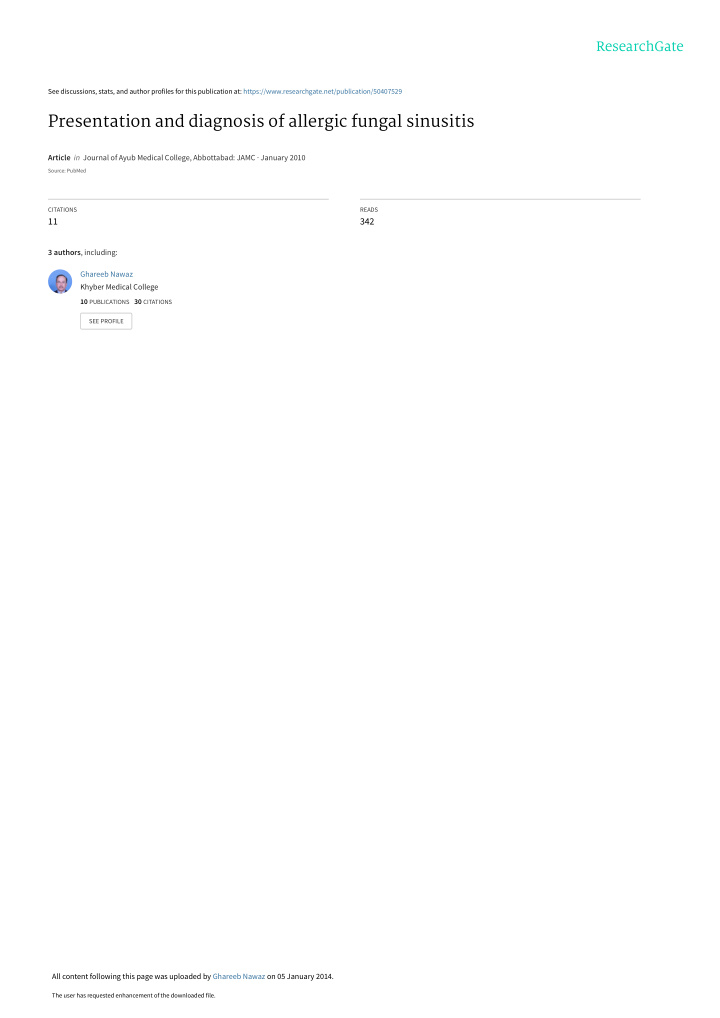



See discussions, stats, and author profiles for this publication at: https://www.researchgate.net/publication/50407529 Presentation and diagnosis of allergic fungal sinusitis Article in Journal of Ayub Medical College, Abbottabad: JAMC · January 2010 Source: PubMed CITATIONS READS 11 342 3 authors , including: Ghareeb Nawaz Khyber Medical College 10 PUBLICATIONS 30 CITATIONS SEE PROFILE All content following this page was uploaded by Ghareeb Nawaz on 05 January 2014. The user has requested enhancement of the downloaded file.
J Ayub Med Coll Abbottabad 2010;22(1) PRESENTATION AND DIAGNOSIS OF ALLERGIC FUNGAL SINUSITIS Zakirullah, Ghareeb Nawaz, Syed Fazle Sattar Department of Otorhinolaryngology, Head & Neck Surgery, Khyber Medical College, Peshawar, Pakistan Background: Allergic fungal sinusitis (AFS) is a form of fungal disease that has recently been considered a distinct clinicopathologic entity. Other forms of fungal sinusitis include acute-fulminant (invasive), chronic indolent (invasive) and mycetoma (non-invasive). Objectives were to assess the presentation and to describe the diagnostic techniques for allergic fungal sinusitis in our setup. Method: Descriptive study was conducted in the Department of ENT and Head & Neck Surgery, Khyber Medical College and Khyber Teaching Hospital, Peshawar from January 2002 to April 2008. Twenty-three cases of allergic fungal sinusitis (ASF) were selected for the study. Data like, name, age, sex, address, clinical features, labs (Eosinophil count) and imaging studies (CT and/or MRI) were recorded, including the pre- and postoperative treatment, operative findings and postoperative results, recurrence of disease were also recorded. Surgical procedures were performed on all cases followed by medical treatment. Results: Study revealed that AFS is a disease of younger age, mainly occurring in 2 nd & 3 rd decade of life, with male to female ratio 1:1.3. Allergic rhinitis (91%) and nasal polyposis (91%) were important associated factors. Nasal obstruction (96%), nasal discharge (91%), post-nasal discharge (87%) and unilateral multi sinus extension were important clinical features. Increased eosinophil count and increased IgE level was found in 78% cases. Histopathological analysis showed fungal hyphae in all cases and aspergillus was predominant organism on culture. Orbital erosion was seen in 78% and skull base erosion was observed in 9%. Recurrence of disease was seen in nine cases. Conclusion: Allergic fungal sinusitis (AFS) is a disease of young immunocompetent adults. Nasal obstruction, nasal discharge, nasal allergy and proptosis were the most common presentations. Initial diagnosis of allergic fungal sinusitis requires high index of suspicion in patients presenting with chronic rhinosinusitis, such cases should be properly evaluated. Differentiation from invasive forms of fungal sinus disease is crucial. Keyword: Sinusitis, Allergic Fungal Sinusitis, Skull base erosion, Orbital erosion, Fungal and culture. 7 This has recently been described a distinct INTRODUCTION clinicopathologic entity by Ferguson as oesinophilic Allergic fungal sinusitis (AFS) is a form of fungal mucin rhinosinusitis (EMRS). 8 disease that has recently been considered a distinct The diagnosis is based, by analogy with the clinicopathologic entity. Other forms of fungal sinusitis findings in bronch-pulmonary aspergillosis, on the include acute-fulminant (invasive), chronic indolent the sinus. 9 presence of allergic mucin within (invasive) and mycetoma (non-invasive). Allergic Macroscopically, the secretions are thick, viscous, and fungal sinusitis a non-invasive pansinusitis that occurs green and microscopically, the allergic mucin contains in young immunocompetent individuals, with a strong eosinophilic polynuclear cells, Charcot-leyden crystals, history of atopy and elevated levels of total and scattered mycelial filaments without tissue invasion. immunoglobulin (Ig)E and peripheral eosinophilia. It is Clinically, allergic fungal rhinosinusitis should be histologically characterised by the presence of allergic suspected in the presence of chronic rhinosinusitis mucin and scattered fungal hyphae. 1 Allergic fungal refractory to several medical or surgical treatments. 9–11 sinusitis (AFS) was first described in the literature in the CT scan shows heterogeneous opacities or early 1980s, when Millar et al noticed a clinical entity of calcifications. The presence of bony erosion of the skull sinus disease that was similar in many ways to allergic base and orbital in AFS has been well documented in bronchopulmonary aspergillosis (ABPA). 2,3 Patients the literature. 12–14 with allergic fungal sinusitis (AFS) have intractable The aim of this study was to assess the sinusitis that fails to respond to repeated courses of presentation of allergic fungal sinusitis and describe the antibiotics and surgical procedures. Criteria for the techniques of diagnosis in our setup. diagnosis are still evolving. Bent et al 4 published the diagnostic criteria of AFS in 1994 4 and deShazo et al in MATERIAL AND METHODS 1995 5 . Recently Schubert prospectively evaluated his This was a descriptive study conducted in the patients with allergic fungal sinusitis and discovered 4 department of Otorhinolaryngology, Head and Neck characteristic findings for the diagnosis as diagnostic Surgery, Khyber Medical College/Khyber Teaching criteria. 6 Some patients may present with clinical and Hospital, Peshawar. The cases presenting with clinical histopathological features similar to AFS but without features of allergic fungal sinusitis were enrolled in the fungal hyphae in allergic mucin by both special stain study between January 2002 and April 2008. http://www.ayubmed.edu.pk/JAMC/PAST/22-1/Zakirullah.pdf 53
Recommend
More recommend